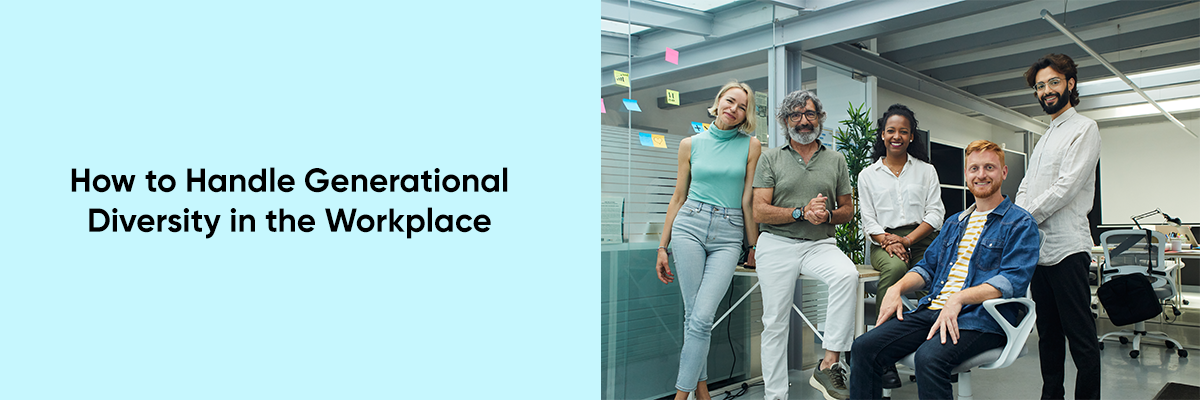In any organization, you’ll find people from different backgrounds, genders, and experiences. Every employee brings something unique to the table, whether it’s their knowledge, education, personality, or life experiences. This diversity is what makes a workplace interesting and innovative. However, managing a diverse workforce can be a challenge for HR, especially when you add age differences into the mix.
When employees come from different generations, the differences go beyond their skills or experience. They also have different work styles, communication preferences, and views on life. These generational differences can make working together more difficult, but with the right approach, they can be turned into an advantage. In this blog, we’ll discuss how to manage generational diversity in the workplace.



This blog is designed to help HR professionals and employers effectively manage their workforce and navigate the challenges of handling diverse employees. If you’re interested in learning more about HR topics from industry experts, we invite you to explore our upcoming webinars on Human Resource Management.
Simply visit our HR webinar page, where you’ll find a variety of on-demand sessions and upcoming events. These webinars offer valuable insights, help you advance your career, and even provide HRCI and SHRM credits, making them a great resource for professional growth. Don’t miss the opportunity to enhance your skills and take your career to the next level!
Understanding Generational Differences
Each generation has its own set of characteristics shaped by the time they grew up in. Here’s a look at the key traits of each generation:
- Baby Boomers (born 1946–1964): Baby Boomers value hard work, stability, and face-to-face communication. They have a wealth of experience and tend to prefer traditional work practices.
- Generation X (born 1965–1980): Gen Xers value independence, work-life balance, and direct communication. They are adaptable and comfortable with technology.
- Millennials (born 1981–1996): Millennials are tech-savvy, value collaboration, and prefer feedback and purpose-driven work.
- Generation Z (born 1997–2012): Gen Z is highly digital, creative, and values flexibility, inclusivity, and social responsibility in their work.
While these traits don’t apply to every individual, they offer a general sense of how each generation tends to work and interact.
How to Handle Generational Diversity in the Workplace
Managing generational diversity requires strategies that encourage teamwork, respect, and understanding across different age groups. Here are some practical ways to handle it:
1. Leverage the Strengths of Each Generation
Each generation brings unique strengths to the workplace, and it’s important to recognize and use these strengths. For example:
- Baby Boomers can offer valuable experience and mentorship.
- Generation X employees are self-reliant and excel in problem-solving roles.
- Millennials are creative, tech-savvy, and great at collaboration.
- Generation Z is highly adaptable to new technologies and can bring fresh perspectives to the workplace.
By aligning roles with the strengths of each generation, you help employees feel valued and contribute effectively to the team.
2. Create Mixed-Generation Teams
Encouraging collaboration between employees from different generations is one of the best ways to break down barriers. When people from different age groups work together, they learn from each other and can find innovative solutions. Here’s how you can promote cross-generational teamwork:
- Form teams with members from different generations: This helps mix fresh ideas with experience. For instance, Baby Boomers can offer insights from their long tenure, while Millennials and Gen Z can bring new tech skills.
- Encourage mentorship: Older employees can mentor younger ones, while younger employees can teach older ones about new technologies or trends. This mutual exchange builds understanding and respect.
3. Promote a Flexible Work Environment
Different generations often have different expectations when it comes to work-life balance and office arrangements. Baby Boomers may prefer traditional office settings, while Millennials and Gen Z might favor remote work options. By offering flexibility, you can create a more inclusive environment. Here’s how:
- Offer flexible work hours and remote work options: Flexibility helps employees of all generations manage their work and personal lives in a way that works best for them.
- Foster open communication: Each generation may prefer different communication methods. Baby Boomers may favor face-to-face meetings, while Millennials and Gen Z might prefer email or digital messaging. Encouraging multiple ways of communicating can make everyone feel more comfortable.
4. Encourage Learning and Growth Across Generations
Creating an environment where all generations can learn from each other is crucial. Here are a few ways to encourage learning and mutual respect:
- Host training sessions or workshops: Encourage employees from all generations to share their knowledge. For example, Baby Boomers can share their experience, while Gen Z can teach new digital tools.
- Offer cross-generational learning opportunities: Pair younger employees with older employees for mentoring or job shadowing. This allows everyone to gain new skills and perspectives.
5. Celebrate and Respect Differences
A culture of mutual respect is essential to managing generational diversity. Encouraging employees to celebrate each other’s differences will help create a positive work environment. Here’s how:
- Acknowledge the value of each generation: Recognize that each generation has something valuable to offer. Celebrate both experience and innovation.
- Encourage team-building activities: Social events or collaborative projects can help employees of different generations get to know each other better, improving communication and teamwork.
Conclusion
Generational diversity in the workplace can be challenging, but it also brings tremendous benefits. When managed well, it leads to innovation, better problem-solving, and a more dynamic workplace culture. By leveraging the strengths of each generation, promoting teamwork, offering flexibility, and encouraging learning, companies can create an inclusive environment where everyone can thrive.
Ultimately, the key to managing generational diversity is respect and open communication. When employees from all generations work together in harmony, the workplace becomes more productive, innovative, and enjoyable for everyone. By embracing generational differences, companies can unlock new opportunities for growth and success.


